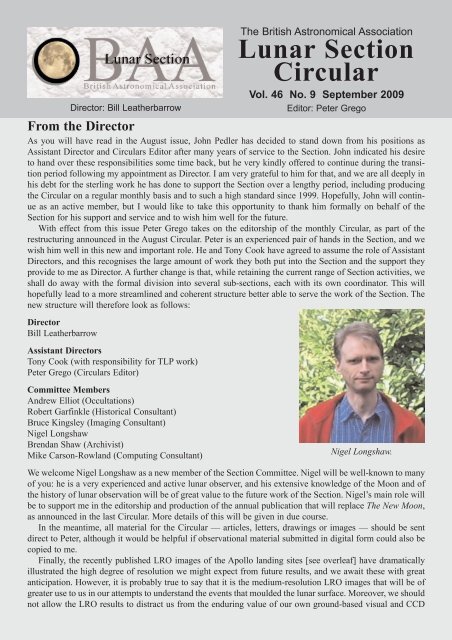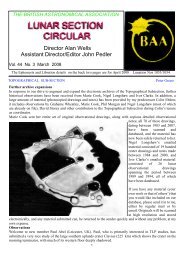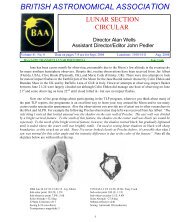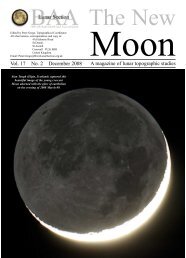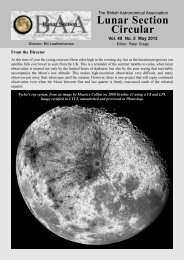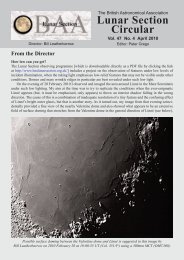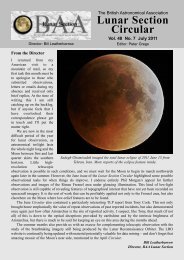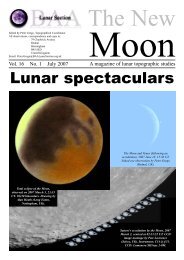Vol 46, No 9, September 2009 - Lunar Section
Vol 46, No 9, September 2009 - Lunar Section
Vol 46, No 9, September 2009 - Lunar Section
You also want an ePaper? Increase the reach of your titles
YUMPU automatically turns print PDFs into web optimized ePapers that Google loves.
Director: Bill LeatherbarrowThe British Astronomical Association<strong>Lunar</strong> <strong>Section</strong>Circular<strong>Vol</strong>. <strong>46</strong> <strong>No</strong>. 9 <strong>September</strong> <strong>2009</strong>Editor: Peter GregoFrom the DirectorAs you will have read in the August issue, John Pedler has decided to stand down from his positions asAssistant Director and Circulars Editor after many years of service to the <strong>Section</strong>. John indicated his desireto hand over these responsibilities some time back, but he very kindly offered to continue during the transitionperiod following my appointment as Director. I am very grateful to him for that, and we are all deeply inhis debt for the sterling work he has done to support the <strong>Section</strong> over a lengthy period, including producingthe Circular on a regular monthly basis and to such a high standard since 1999. Hopefully, John will continueas an active member, but I would like to take this opportunity to thank him formally on behalf of the<strong>Section</strong> for his support and service and to wish him well for the future.With effect from this issue Peter Grego takes on the editorship of the monthly Circular, as part of therestructuring announced in the August Circular. Peter is an experienced pair of hands in the <strong>Section</strong>, and wewish him well in this new and important role. He and Tony Cook have agreed to assume the role of AssistantDirectors, and this recognises the large amount of work they both put into the <strong>Section</strong> and the support theyprovide to me as Director. A further change is that, while retaining the current range of <strong>Section</strong> activities, weshall do away with the formal division into several sub-sections, each with its own coordinator. This willhopefully lead to a more streamlined and coherent structure better able to serve the work of the <strong>Section</strong>. Thenew structure will therefore look as follows:DirectorBill LeatherbarrowAssistant DirectorsTony Cook (with responsibility for TLP work)Peter Grego (Circulars Editor)Committee MembersAndrew Elliot (Occultations)Robert Garfinkle (Historical Consultant)Bruce Kingsley (Imaging Consultant)Nigel LongshawBrendan Shaw (Archivist)Mike Carson-Rowland (Computing Consultant)Nigel Longshaw.We welcome Nigel Longshaw as a new member of the <strong>Section</strong> Committee. Nigel will be well-known to manyof you: he is a very experienced and active lunar observer, and his extensive knowledge of the Moon and ofthe history of lunar observation will be of great value to the future work of the <strong>Section</strong>. Nigel’s main role willbe to support me in the editorship and production of the annual publication that will replace The New Moon,as announced in the last Circular. More details of this will be given in due course.In the meantime, all material for the Circular — articles, letters, drawings or images — should be sentdirect to Peter, although it would be helpful if observational material submitted in digital form could also becopied to me.Finally, the recently published LRO images of the Apollo landing sites [see overleaf] have dramaticallyillustrated the high degree of resolution we might expect from future results, and we await these with greatanticipation. However, it is probably true to say that it is the medium-resolution LRO images that will be ofgreater use to us in our attempts to understand the events that moulded the lunar surface. Moreover, we shouldnot allow the LRO results to distract us from the enduring value of our own ground-based visual and CCD
observations. We cannot match the resolution of LRO, but there is still much to be done in the way of timeandlighting-dependent observation, as illustrated in the observations in last month’s Circular of Plato (by PhilMorgan and Steve Lang), of Polybius K (by Nigel Longshaw and Mike Brown), and of the strange linear featurenear the Straight Wall. Mike Brown’s sequence of images of the Straight Wall area illustrates perfectlythe value of systematic observation under a range of different lighting conditions, and this is work we can allseek to emulate as the nights begin to get longer.Bill LeatherbarrowCrater name Euclides D restored by IAUWhen the International Astronomical Union (IAU) adopted the first officiallunar nomenclature list in 1932, they designated a crater at 09°.4 S,25°.7 W, as Euclides D, as originally named by Johann Mädler in the1830s. The Eratosthenian-age bright rayed-cone crater, located southeastof Montes Riphaeus, is about 6.1 km (3.7 miles) in diameter and1260 metres (4133 feet) deep. In 1976, the IAU changed the designationof Euclides D to ‘Eppinger’. The new designation was thus named tohonor the Czechoslovakian-born Austrian physician Hans Eppinger, Jr.(1879-19<strong>46</strong>), but in October 2002, the IAU dropped the name when itwas discovered that he had conducted cruel experiments on Gypsy prisonersat the German Dachau concentration camp during World War II.Soon after the Eppinger designation was dropped, I asked JenniferBlue at the United States Geological Survey office in Flagstaff. Arizonawhat was going to happen to the designation for this crater. Was the IAUgoing to restore the Euclides D designation or leave the crater sans aname? In June <strong>2009</strong>, I again posed the question to Jennifer and she gotthe IAU to make a decision. In July <strong>2009</strong>, the name Euclides D was officiallyrestored by the IAU. Jennifer Blue is in charge of maintaining theIAU’s official Planetary <strong>No</strong>menclature database. The IAU planetarynomenclature database is online at: http://planetarynames.wr.usgs.gov/.Robert A. Garfinkle, FRAS2NASA’s new Moon probe, <strong>Lunar</strong>Reconnaissance Orbiter (LRO)has succeeded in imaging all sixApollo landing sites in sufficientdetail to clearly discern theremaining <strong>Lunar</strong> Module descentstages. LRO reached its initiallunar orbit on 23 June and capturedthe Apollo sites between 11and 15 July. In the image here,the descent stage of Eagle(arrowed) casts a prominentshadow to its west (lightingopposite to when it arrived thereon 20 July 1969). In one image— that showing the Apollo 14 site— scientific equipment andtracks left in the lunar soil by theastronauts can be discerned. LROwill continue to secure high resolutionimages from its near-circularorbit at an altitude of 50 kmabove the Moon.Observed on <strong>2009</strong> April 4 from21:50 to 22:30 UT by PeterGrego, could this be the last evervisual sketch of the craterEppinger (crater at top)?BAA <strong>Lunar</strong> <strong>Section</strong> Circular <strong>Vol</strong>. <strong>46</strong> <strong>No</strong>. 9 <strong>September</strong> <strong>2009</strong>
Topographical notesPeter GregoVisual studies and observationsSince the last report in August’s LSC, observational drawings have been received from Peter Grego (StDennis, Cornwall, UK), Dale Holt (Chipping, Hertfordshire, UK), Andrew Johnson (Kirkby Malzeard,<strong>No</strong>rth Yorkshire, UK) and Phil Morgan (Tenbury Wells, Worcestershire, UK).Follow-up: Plato ashen lightFurther to his observation of an unusual apearance to Plato’s shadowed interior on <strong>2009</strong> June 16 (see LSC<strong>Vol</strong>. <strong>46</strong> <strong>No</strong>. 9, August <strong>2009</strong>, p5) Phil Morgan reports that he has since heard from John Moore (a frequentcontributor to the LPOD website http://lpod.wikispaces.com) who made the suggestion that he may have beenobserving the effects of light reflected from a nearby peak on Plato’s wall.Phil writes: “Thinking more about it, it does seem to be the only really logical solution. What I saw certainlywasn’t the sunlight catching a raised portion of the crater floor — I’ve seen that effect enough timesnot to be fooled, and in any case it would not have illuminated much of remaining crater floor as I noted.Atmospheric effects can be ruled out, since transparency was perfect, and no other craters were exhibiting theeffect. <strong>No</strong> coloured glows were seen, so almost certainly no gaseous emissions taking place, nor dust storms,I would think it impossible for them to produced a milky glow, and in any case extremely unlikely that it couldbe anything like that. This leaves us with some kind of illumination. Does reflected light occur on the Moon?Yes it certainly does. An illuminated,extended crater rim can scatterenough light to illuminate a shadedcrater. The Japanese Kaguyaprobe was able to see inside thepermanently shaded south polarcrater, Shackleton using this scatteredlight approach. The intensityof illumination from a brightlyilluminated peak will drop off bythe inverse square law, the energytwice as far from the source isspread over four times the area. Ipresume that this would mean thatit must be a fairly nearby peak tothe brightest area of illuminatedfloor, in my case the southern floorarea. I have looked closely at severalimages of Plato and I thinkthat I may have identified a coupleof likely peaks on the south crestof Plato that that could possibly beresponsible for the effect (at right).I have to say that this is only speculationon my part — we reallyneed some images of a similarevent to be certain, though I suspectwe will have a long wait!”Further to this, Richard Baumsent Phil a report of a similarsighting by A. Stanley Williamswhich featured in theSelenographical Journal of 1882May 17. Nigel Longshaw reportsPhil Morgan identifies two points on the rim of Plato that may havebeen responsible for the ‘ashen light’. Image by Bruno Daversin.BAA <strong>Lunar</strong> <strong>Section</strong> Circular <strong>Vol</strong>. <strong>46</strong> <strong>No</strong>. 9 <strong>September</strong> <strong>2009</strong> 3
that in addition to Williams’ observation of a milky whiteness, this was also reported by Birt, Schroeter andothers. Phil notes: “Of course, Williams’ observation was made under exactly opposite lighting to mine, butalso under precisely opposite libration. I’m not sure if that is relevant, but both our observations were madeunder very oblique lighting and I think that that is probably significant in any analysis.”Finally, Tony Cook unearthed a report from 1981 Oct 21 at UT 11:35 - 11:48 by B. Hobdell (see TLP reporton page 8).Cichus and the Rima Hesiodus, by Phil MorganThe purpose of the observation (reproduced below) made on <strong>2009</strong> April 4, was to follow up Harold Hill’sstudy of 1983 February 21, when he noticed an apparent bridging or stepped appearance of the short rille/faultthat runs just to the south of the Hesiodus rille where it encounters the promontory that travels north from theCichus northern outer rampart, Harold’s drawing appears on page 116 of his Portfolio of <strong>Lunar</strong> Drawings.Cichus itself is about 41 kilometres wide with a couple of low hills on the interior and broad bright rampartsthat contrast with the small dark bay to the west, a small extension of the Palus Epidemiarum. This beingbounded on the west by the outer western flank of Capuanus and to the east by the barrier mentioned above,a natural dividing wall between the Mare Nubium and the Palus Epidemiarum. To the east of this wall are theflooded remains of the ancient crater Weiss, 66 kilometres. Perched somewhat precariously on the westernrim of Cichus is the 11 kilometre bowl crater Cichus C.Webb became interested in Cichus C in 1833 when he noticed that it appeared to be twice the diameter asdepicted by Johann Schroter on his map of 1792, drawn some half a century before the first ever-lunar photographwas taken. This led him (mistakenly) to conclude that it had grown in the meantime! InterestinglySchmidt drew C as lying outsidethe rampart of Cichus — probablyjust a slight positional error on hispart. One of the bright rays fromTycho passes tangentially just tothe northeast of the rim of Cichus.Unfortunately, on this occasionthe illumination was too faradvanced, at colongitude 26.6°,for any bridging of the fault to bevisible. This fault/rille is ratherinteresting in itself, since it representsquit a considerable break inthe barrier at this stage of illumination,and doesn’t appear to berelated to any great rille system.Possibly it came about by the dippingof the terrain to the north —the same forces that led to the formationof the Hesiodus rille.Nevertheless a somewhatrushed observation of the regionwas attempted, with the result portrayedopposite. Four small craterletswere glimpsed in bettermoments on the floor of the PalusEpidemiarum. These were subsequentlyconfirmed in the TimesAtlas, and just to the south ofthese, and due west of Cichus,there appears to be the remains ofa ruined ring.4BAA <strong>Lunar</strong> <strong>Section</strong> Circular <strong>Vol</strong>. <strong>46</strong> <strong>No</strong>. 9 <strong>September</strong> <strong>2009</strong>
An attempt was also made to see if there was any indication of the great Hesiodus rille cutting through thispromontory that runs north from Cichus. But any definite sign of it crossing the barrier proved negative onthis occasion. It is easy to lose track of the scale of things when lunar drawing — for example, I show theHesiodus rille about 10 mm across, but in fact at this point on the lunar surface it some 5 kilometres wide andabout 1 kilometre deep. Imagine being transported to the Moon and standing on the edge of rille and lookingto the other side!It was, however, intriguing to note that it was the northern inner scarp of the Hesiodus rille that was illuminated.Being situated at 31° S one might expect it to be the southern inner wall that would be catching thesolar rays.The first clue is the angle of the spires of shadow stretching westwards from the isolated peaks in the PalusEpidemiarum. These are spreading slightly to the north, and this tells us that the Hesiodus rille is not runningdue east to west. In fact as it strikes 300 kilometres westwards it travels from 29° to over 32° S, some 80 kilometresmeasured on the lunar surface. All fairly basic stuff you may say, but such facts are not always rememberedwhen you notice something in the eyepiece that appears inexplicable!Comment by Bill Leatherbarrow: “I was interested by your comment that you did not detect the greatHesiodus rille crossing the mountainous apron north of Cichus. I would expect it to do so (in the same waythat the Ariadaeus rille can be seen to traverse the blocks of material that cross that rille’s path). <strong>Lunar</strong> Orbiterframe LO4-125HI ‘suggests’ that it does, but is not entirely conclusive, and I would suggest that this is somethingelse we might look out for under the right conditions of illumination. It’s not entirely a minor matter,for the more we look at rilles in general, the less we (or, at least, I for one) understand about them and theirbehaviour!Nicollet and Birt, by Peter GregoAn interesting ultra-low evening Sun illumination of thecrater Birt and environs. Birt’s western outer wall wasilluminated by the diminishing sunlight while surroundingit virtually the entire area of Mare Nubium up to the lowdorsa east of Nicollet was engulfed in shadow. Birt’s westernflanks appeared as a bright L-shaped crescent; a duskyband bisected the central western part of the crescent; thesouthern tip of the crescent was disconnected by a line ofshadow; a small sliver of illumination was observed justwest of the crescent’s northern tip. Several faint greypatches of illumination were seen within the shadow inthe vicinity of the dome upon which Birt E sits. The ridgesbetween Nicollet and Promonotorium Taenarium formedwhat appeared to be a prominent plateau with a sharpsouthwest-pointing bow. Nicollet was largely shadowfilled,and was surrounded by several dorsa emanatingfrom its flanks. A dusky band was observed on the illuminatedinner eastern wall of Nicollet. The ridges at the terminatorin the southern part of this observational drawingare not as well depicted as in the rest of the observationowing to the sudden onset of cloud which ended the session.Yahoo! Group — topographic studiesIf you’d like to see more of the BAA <strong>Lunar</strong> <strong>Section</strong>’sobservations, along with some of those mentioned above,you’re most welcome to join our Yahoo! Group athttp://uk.groups.yahoo.com/group/baalunarsection-topography/It’s easy to join – simply follow the on-screeninstructions and I will sign you in as quickly as possible.BAA <strong>Lunar</strong> <strong>Section</strong> Circular <strong>Vol</strong>. <strong>46</strong> <strong>No</strong>. 9 <strong>September</strong> <strong>2009</strong> 5
<strong>Lunar</strong> imagesSince the last Topographical notes, many excellent lunar CCD images have been received from: Mike Brown(Huntington, York, UK), Maurice Collins (Palmerston <strong>No</strong>rth, New Zealand), Bill Dembowski (Elton, PA,United States), Dave Finnigan (Halesowen, UK), Mike White (Levin, New Zealand).Dave Finnigan’s image of the MareHumboldtianum region, <strong>2009</strong> May 31.Maurice Collins’ image of the Mare Humboldtianumregion, <strong>2009</strong> July 27.Mare HumboldtianumDave Finnigan has submitted an imageof the Mare Humboldtianum area, takenon <strong>2009</strong> May 31 at 22:20 UT with an 8-inch SCT operating at f/10, and using aDMK21 mono camera. The colongitudeat the time was 3.8°. Dave has caughtthe region at a very favourable libration,and the result is a striking and revealingpicture of a much under-observedregion. Mare Humboldtianum is thelava-flooded centre of a 640 km widemulti-ring basin, whose true nature maybe glimpsed only under the sort of librationconditions captured by Dave. Hisimage clearly shows the dark marematerial sitting within, but not completelyfilling, a 300 km wide inner rim.The outer rim may also be clearly tracedas it passes between the mare and thedark-floored crater Endymion, and itthen curves around the far side of themare on to the horizon. One intriguingdetail is how linear the outer rim appearsas it passes Mercurius and Endymion onits way towards de la Rue and Strabo. Isthis real, or just a misperception createdby other linear features in the area?Imagery from Orbiter and Clementine isinconclusive.Other rarely seen features in theimage include the crater Belkovich (198km), with its non-central peaks, and thedark-floored rim crater Belkovich Abetween Belkovich and MareHumboldtianum. Also clearly visible arethe inner terraces and central peaks ofthe well-formed crater Hayn in the farupper-left of the image. Distinct brightrays from the area of Hayn cross thefloor of the mare and pass close toMercurius. Where do they originate?Despite Dave’s fine image, there arestill many questions unresolved in thisarea, and it is to be hoped that the<strong>Section</strong>’s visual observers and imagerswill take advantage of future favourablelibrations.Bill Leatherbarrow6BAA <strong>Lunar</strong> <strong>Section</strong> Circular <strong>Vol</strong>. <strong>46</strong> <strong>No</strong>. 9 <strong>September</strong> <strong>2009</strong>
Maurice Collins’ imagemontage of the Moon’ssouthern highlands,<strong>2009</strong> July 29.BAA <strong>Lunar</strong> <strong>Section</strong> Circular <strong>Vol</strong>. <strong>46</strong> <strong>No</strong>. 9 <strong>September</strong> <strong>2009</strong> 7
BAA/ALPO Transient <strong>Lunar</strong> PhenomenaTony CookObservations for Jul <strong>2009</strong> were received from the following observers: Jay Albert (Lakeworth, FL, USA),Steve Chadwick (New Zealand), Maurice Collins (Palmerston <strong>No</strong>rth, New Zealand), Tony Cook(Aberystwyth, UK), Marie Cook (Mundesley, UK), John Field (New Zealand), Steve Lang (Stanley Bay,New Zealand), Bob O’Connell (FL, USA) and Mike White (Levin, New Zealand). Again I’m veryimpressed by the quantity and quality of observations submitted by our New Zealand observers – MauriceCollins should be congratulated in getting so many amateurs out there to look at the Moon.TLP reports: There are 0 TLP reports for July, although Bob O’Connell (FL, USA) sent me a couple ofimages of what he referred to as a “false TLP” sighting of an apparent lunar flare beyond the terminator. Thesighting was made at 09:54UT on <strong>2009</strong> Jul 16, near Lambert. Due to the spot’s apparent excessive brightness,he got in contact with another observer, Bob Duvall and both agreed over the brightness. I guess though thatafter checking charts and monitoring its fairly stable brightness over tens of minutes, they soon realized thatit was indeed just a tall mountain with sun facing slope. Interestingly Bob mentions that there is a TLP reportfor another nearby mountain exhibiting this effect is described in Cameron’s 1978 catalog (ID=312): on 1902Aug 13 UT 00:50 — Jones of Philadelphia observed a “brilliant star-like point near Lambert on the dark sideof the terminator of magnitude 3-4 with a diffraction ring! As the terminator neared it the point turned into avery brilliant spot”. Over the years I have seen a number of false TLP reports like this, though they pertainmostly to Pico and Piton.Concerning the ashen light effect seen at sunset on the floor of Plato on <strong>2009</strong> Jun 16 UT 03:20-03:40 byPhil Morgan (UK) I came across the following description for a TLP noted by B. Hobdell (St Petersberg, FL,USA) on 1981 Oct 21 UT 11:35-11:48 – “found that the south peak of Plato on floor glowed white at11:35UT, then a milky shade spread all around Plato’s floor (previously completely shadow filled). The needlelike shadows started to be indistinguishable through the sunlight (dawn on Earth). The cloud like featurewas washed out by daylight at 11:48UT and conformed to the white area except a tail that reached the centreof Plato”.Please compare the above with Phil Morgan’s description given in last month’s article – the co-longitudescoincide, and so probably both reports are illumination effects. Nevertheless I would suggest strongly thatobservers have a go at trying to monitor sunset on Plato at the times listed below (assuming the Moon is abovethe horizon and it is night at your observing site) – please attempt sketch sequences or CCD time lapse imagingwith exposures sufficient to pick up detail in the shadow. From Morgan and Hobdell’s accounts I thinkthat you will find sunset at Plato an awesome sight and well worth getting up early in the morning to see:DateUT<strong>2009</strong> Sep 12 12:53-13:14 (day light in UK)<strong>2009</strong> Oct 12 01:23-01:44<strong>2009</strong> Dec 10 05:03-05:23Routine reports: I am enclosing some illustrative examples of routine reports and their relevance to past TLPreports with the hope that this will encourage others to submit routine observations:Above: A subset of CCD image mosaics from New Zealand observers on <strong>2009</strong> Jul 08 taken in sequence.(Left) Maurice Collins UT 09:16-09:33 in white light, (Centre) Mike White UT 09:38-10:45 in white light,(Right) Steve Chadwick UT 12:30-12:40 in Hydrogen Alpha.8BAA <strong>Lunar</strong> <strong>Section</strong> Circular <strong>Vol</strong>. <strong>46</strong> <strong>No</strong>. 9 <strong>September</strong> <strong>2009</strong>
On <strong>2009</strong> Jul 12 at UT 23:20-23:35 Marie Cook (Mundesley, UK) checked out several listed features, but foundeverything normal. On <strong>2009</strong> Jul 05 UT 03:35-05:20 Jay Albert (FL, USA) observed Herodotus, Aristarchus, andGassendi and found everything normal.For those of you without access to the Internet (in the UK), below is a list of repeat conditions for when a featurewill exhibit the same illumination and libration as was seen for a historical TLP observation from the past. Byre-observing and submitting your observations, we will get a clear understanding of what the feature ought to havelooked like at the time. Only this way can we really fully analyze past TLP reports. I have also included someEarthshine observing sessions.Event: Aristarchus (observed by Olivarez, 1968 Mar 14) can be seen on/from (UT): <strong>2009</strong> Sep 03/04 (22:35-01:09) – [Check crater south wall and central peak with red and blue filters]Event: Proclus (observed by Bartlett, 1955 Aug 03 and 1956 Oct 18) can be seen on/from (UT): <strong>2009</strong> Sep 03/04(23:21-03:52) – [Please sketch or image the crater, especially at the foot of the inner north east wall, also how darkis the floor, especially when seen through a green filter?]Event: Aristarchus (observed by Bartlett, 1955 Aug 03) can be seen on/from (UT): <strong>2009</strong> Sep 04 (00:23-04:19) –[Check the colour of adjacent highland to the crater]Event: Manilius (observed by Firsoff, 1955 Aug 03) can be seen on/from (UT): <strong>2009</strong> Sep 04 (19:02-20:40) –[How bright is this crater compared to other bright craters of similar size and any difference if you use a blue filter?]Event: Timocharis (observed by Firsoff, 1955 Aug 03) can be seen on/from (UT): <strong>2009</strong> Sep 04 (19:02-20:40) –[How bright is this craterin blue light? Describe its relative size to other craters and its sharpness.]Event: Madler (observed by Wildey, 1962 Apr 22) can be seen on/from (UT): <strong>2009</strong> Sep 06/07 (21:53-04:54) –[Please monitor the brightness of this crater over time]Event: Kant (observed by Brook, 1991 Aug 29) can be seen on/from (UT): <strong>2009</strong> Sep 08 (05:23-05:35) – [Howbright is the east wall of this crater compared to walls of nearby craters?]Event: Aristarchus (observed by Louderback, 1991 Jul 31) can be seen on/from (UT): <strong>2009</strong> Sep 09 (00:59-03:59)– [What colour is the south floor and the ray going towards Herodotus?]Event: Piton (observed by Louderback, 1991 Jul 31) can be seen on/from (UT): <strong>2009</strong> Sep 09 (00:59-03:59) –[Would you say that the mountain was darker than normal? Compare brightness to other similar sized landmarks]Event: Aristarchus (observed by Bartlett, 1956 Jun 29) can be seen on/from (UT): <strong>2009</strong> Sep 10 (03:30-05:39) –[Can you see any colour in the crater?]Event: Earthshine (Sporadics) can be seen on/from (UT): <strong>2009</strong> Sep 12 (01:38-05:04) – [Look for impact flasheson the night side of the Moon – there will be one every few hours on average]Event: Earthshine (Sporadics) can be seen on/from (UT): <strong>2009</strong> Sep 13 (00:57-05:05) – [Look for impact flasheson the night side of the Moon – there will be one every few hours on average]Event: Earthshine (Sporadics) can be seen on/from (UT): <strong>2009</strong> Sep 14 (02:10-05:07) – [Look for impact flasheson the night side of the Moon – there will be one every few hours on average]Event: Earthshine (Sporadics) can be seen on/from (UT): <strong>2009</strong> Sep 15 (03:30-05:09) – [Look for impact flasheson the night side of the Moon – there will be one every few hours on average]Event: Earthshine (Sporadics) can be seen on/from (UT): <strong>2009</strong> Sep 16 (04:55-05:11) – [Look for impact flasheson the night side of the Moon – there will be one every few hours on average]Event: Aristarchus and Cassini (observed by Foley and Amery, 1980 Apr 18) can be seen on/from (UT): <strong>2009</strong>Sep 22 (18:01-18:03) – [How bright or dark is Aristarchus in Earthshine compared to other features and any colourseen? Are you able to see Cassini in Earthshine?]Event: Montes Carpatus (observed by McCorkle, 1955 Aug 27) can be seen on/from (UT): <strong>2009</strong> Sep 27 (22:14-22:25) – [Please photograph or image the Earthshine]Event: Schroter’s Rille (observed by Firsoff, 1955 Aug 29) can be seen on/from (UT): <strong>2009</strong> Sep 30 (17:42-20:09)– [Can you see this rille through a blue filter?]For repeat illumination TLP predictions for the coming month, these can be found on the following web site:http://users.aber.ac.uk/atc/tlp/tlp.htm .For members who do not have access to the internet, please drop me a line andI will post predictions to you. If you would like to join the TLP telephone alert team, please let me know your phone<strong>No</strong>. and how late you wish to be contacted. If in the unlikely event you see a TLP, please give me a call on my cellphone: +44 (0)798 505 5681 and I will alert other observers. <strong>No</strong>te when telephoning from outside the UK you mustnot use the (0). When phoning from within the UK please do not use the +44!Dr Anthony Cook, Institute of Mathematical and Physical Sciences, University of Wales Aberystwyth,Penglais, Aberystwyth, Ceredigion, SY23 3BZ, Wales, United Kingdom. Email: tlp@baalunarsection.org.ukBAA <strong>Lunar</strong> <strong>Section</strong> Circular <strong>Vol</strong>. <strong>46</strong> <strong>No</strong>. 9 <strong>September</strong> <strong>2009</strong> 9
Occultation newsAndrew ElliottGood graze!One grazing occultation is predicted this month – on the evening of Tuesday <strong>September</strong> 29. This is track 16on the graze map printed in the February LSC, and track 9 in the <strong>2009</strong> BAA Handbook (pp.35-36). The trackcrosses parts of S Cornwall, N Devon, SW Wales including Cardiff, the central Midlands including Worcesterand Birmingham, S Derbys, N <strong>No</strong>tts, N Lincs, and the East Riding of Yorkshire. Magnitude 5.3 star ZC 3108(29 Cap) is grazed by the southern limb of the 82% sunlit Moon.The graze commences at around 21:<strong>46</strong> UT (22:<strong>46</strong> BST) at landfall in the south west, and the Moon will beat an elevation of around 21°, just past the meridian. The graze takes place entirely against the dark limb at acusp angle of around 15°. The Moon’s predicted profile is very rugged at the graze point and events should beseen from 5 km NW to 4 km SE perpendicular to the central track. Multiple events are possible within therange 5 km NW to 1 km SE of the track. It should be easily visible in small telescopes.A detailed prediction, including OS map references for the track and an ASCII representation of the Moon’slimb, and a detailed explanatory note for these graze predictions (MS Word format), can be downloaded from:http://www.warton.f2s.com/Misc/29CapGraze09.txt and http://www.warton.f2s.com/Misc/GrazKey.docClear Skies!N.B. Don’t forget to add 1 hour to the above times during British Summer Time!Key to less obvious column entries in predictions above:Predictions are computed for a telescope aperture of 150mm using a detailed observability algorithm. Lowercase D, R, Gr in Phase column means the star is within 1 magnitude of observability limit, i.e. less easy to see.M, or m, indicate a bright star miss at the above coordinates, but which may be an occultation nearby. Star catalogue,nnnn = ZC, nnnnn or nnnnnn = SAO, Xnnnnn = XZ80, ?nnnn = other catalogue, where ‘?’ is a letterindicating the catalogue. Character in ‘D’ column indicates a double star – careful timing/video recording mayreveal the duplicity. Character in ‘V’ column indicates a variable star. (Extra information lines for double/variablestars removed to save space.) Other entries are as for the pre-2007 predictions produced by OCCMOONin previous LSCs. Predictions courtesy of David Herald’s Occult program, version 3.6.10BAA <strong>Lunar</strong> <strong>Section</strong> Circular <strong>Vol</strong>. <strong>46</strong> <strong>No</strong>. 9 <strong>September</strong> <strong>2009</strong>
Libration <strong>September</strong> <strong>2009</strong>Editor’s note: In previous issues of the <strong>Lunar</strong> <strong>Section</strong>Circular, much of the lunar data, including libration tables,physical data and occulations tables pertained to themonth following that issue’s date; for example, the Augustissue contained information about <strong>September</strong> events. Torationalise things, all lunar data will now pertain to themonth of issue, and we are therefore reprinting<strong>September</strong>’s data in this issue.BAA <strong>Lunar</strong> <strong>Section</strong> Circular <strong>Vol</strong>. <strong>46</strong> <strong>No</strong>. 9 <strong>September</strong> <strong>2009</strong> 11
To receive B&W printed copies of the <strong>Lunar</strong> <strong>Section</strong> Circular, please send a supply of stamped addressedenvelopes to the <strong>Lunar</strong> <strong>Section</strong> Director. Envelopes at least 11 x 22 cm will ensure no damage in transit.Members who have Internet access may receive their Circulars (colour version) in PDF format by email(please contact the Director) or by downloading them directly from the BAA <strong>Lunar</strong> <strong>Section</strong> website athttp://www.baalunarsection.org.uk/circulars.htm.BAA <strong>Lunar</strong> <strong>Section</strong> Director: Bill Leatherbarrow, 9 Stumperlowe Avenue, Sheffield, S10 3QN, UK.Email: director@baalunarsection.org.ukObservations and items related to a specific area of lunar study should be sent to the appropriate memberof the BAA <strong>Lunar</strong> <strong>Section</strong> Committee (see page 1), but send any material of a more general nature to theEditor. Items for the October <strong>Lunar</strong> <strong>Section</strong> Circular should reach the Editor by 10 <strong>September</strong> <strong>2009</strong>.Circulars Editor: Peter Grego, 7 Parc-An-Bre Drive, St Dennis, St Austell, Cornwall, PL26 8AS, UK.Email: editor@baalunarsection.org.uk12BAA <strong>Lunar</strong> <strong>Section</strong> Circular <strong>Vol</strong>. <strong>46</strong> <strong>No</strong>. 9 <strong>September</strong> <strong>2009</strong>


